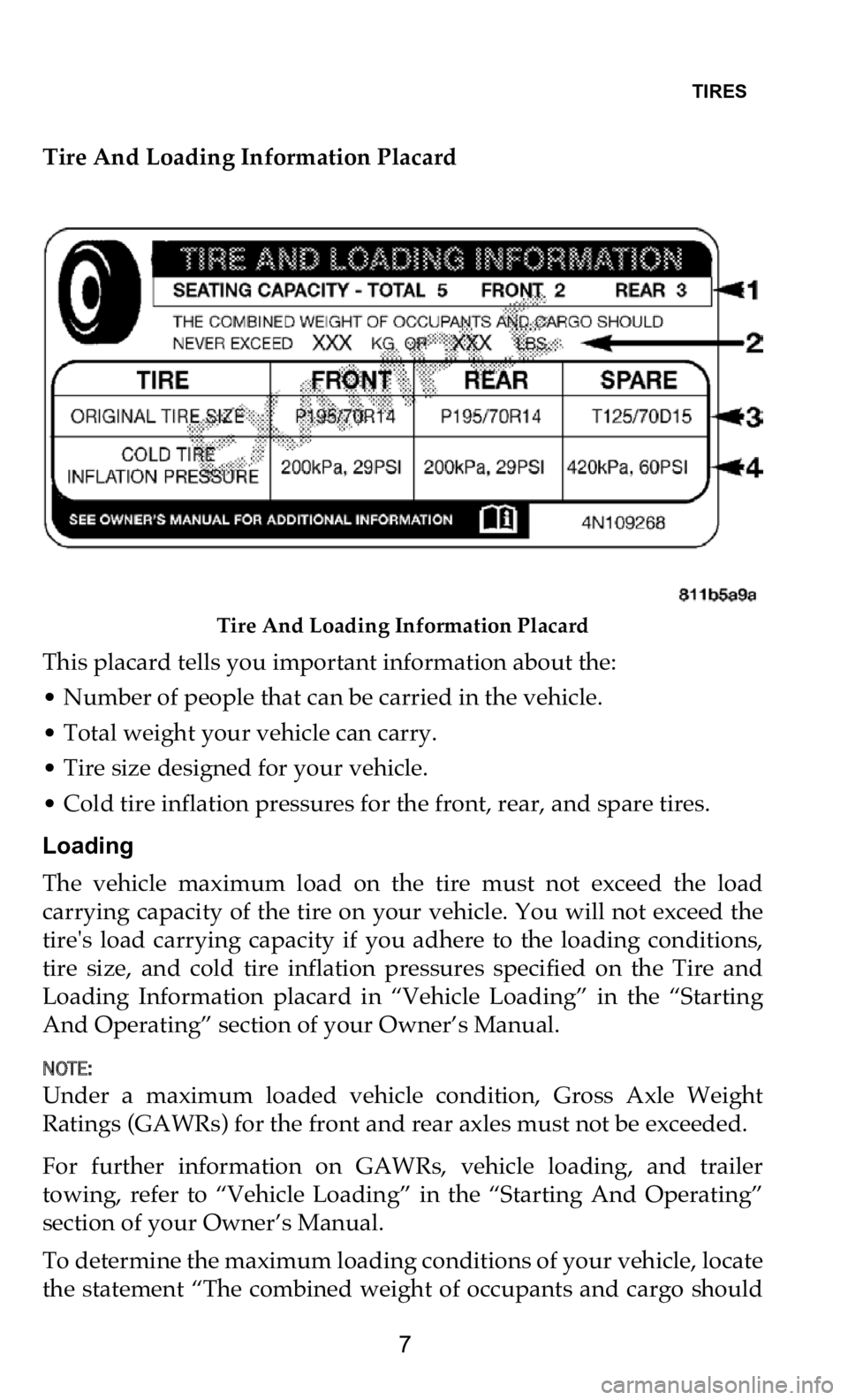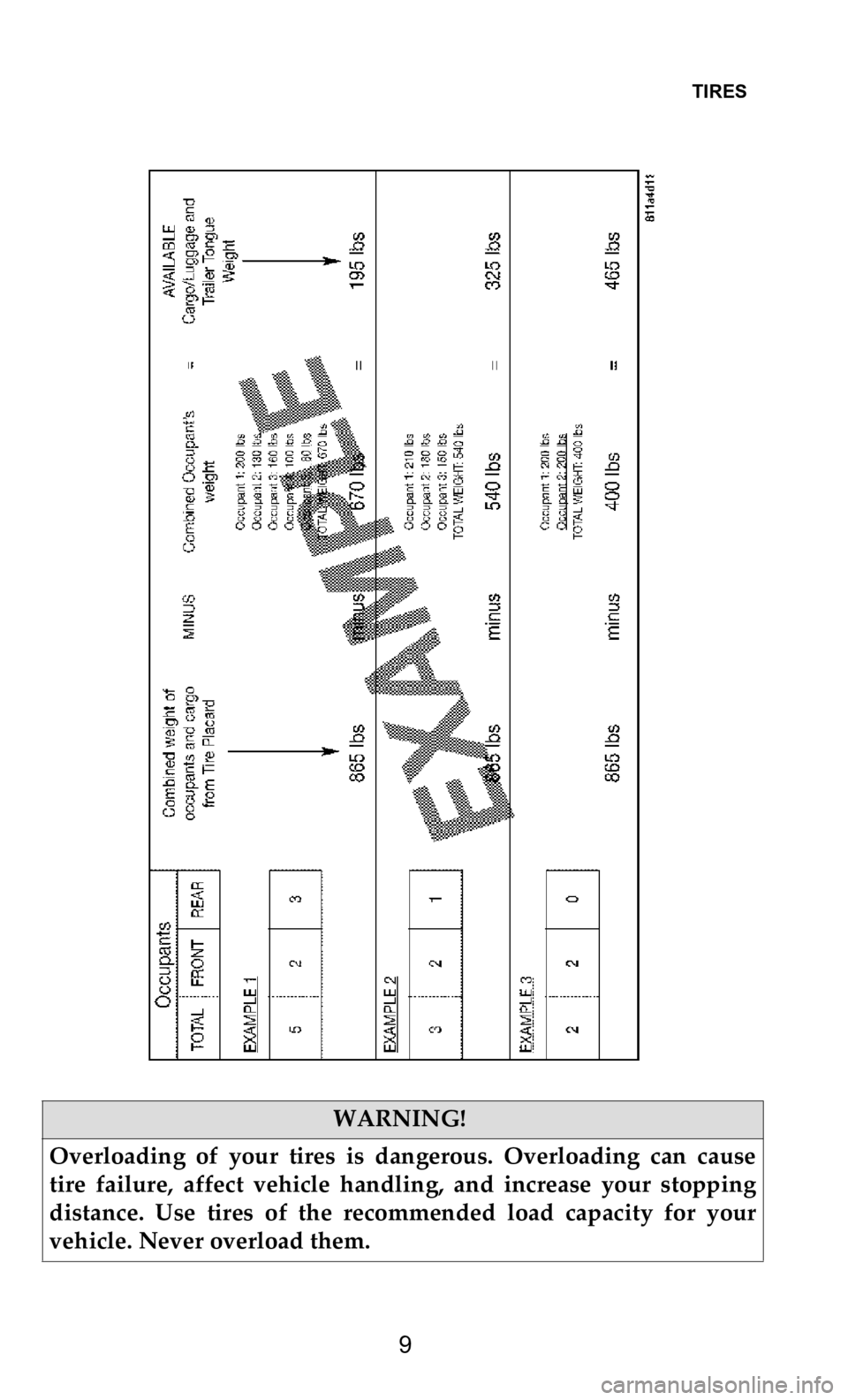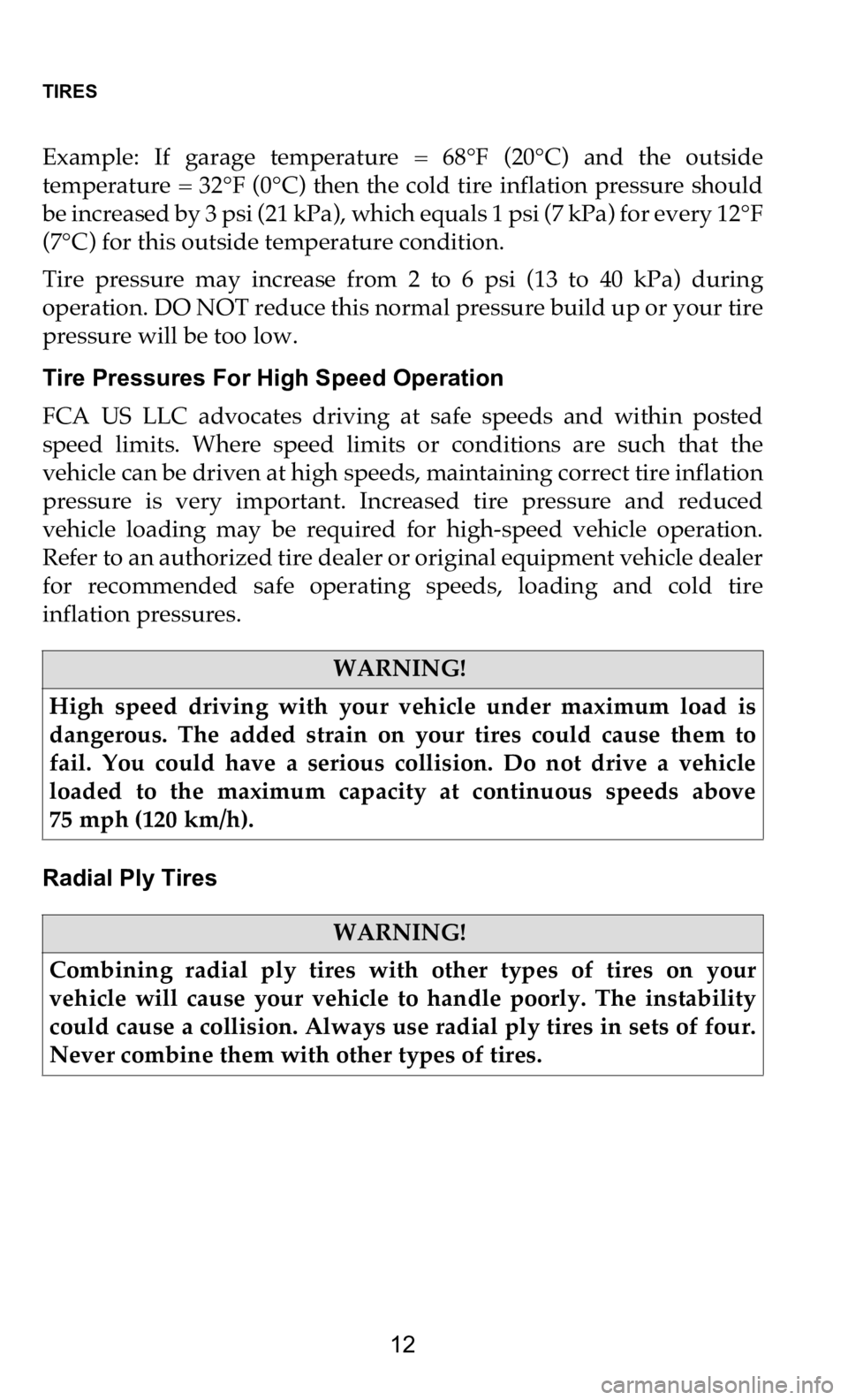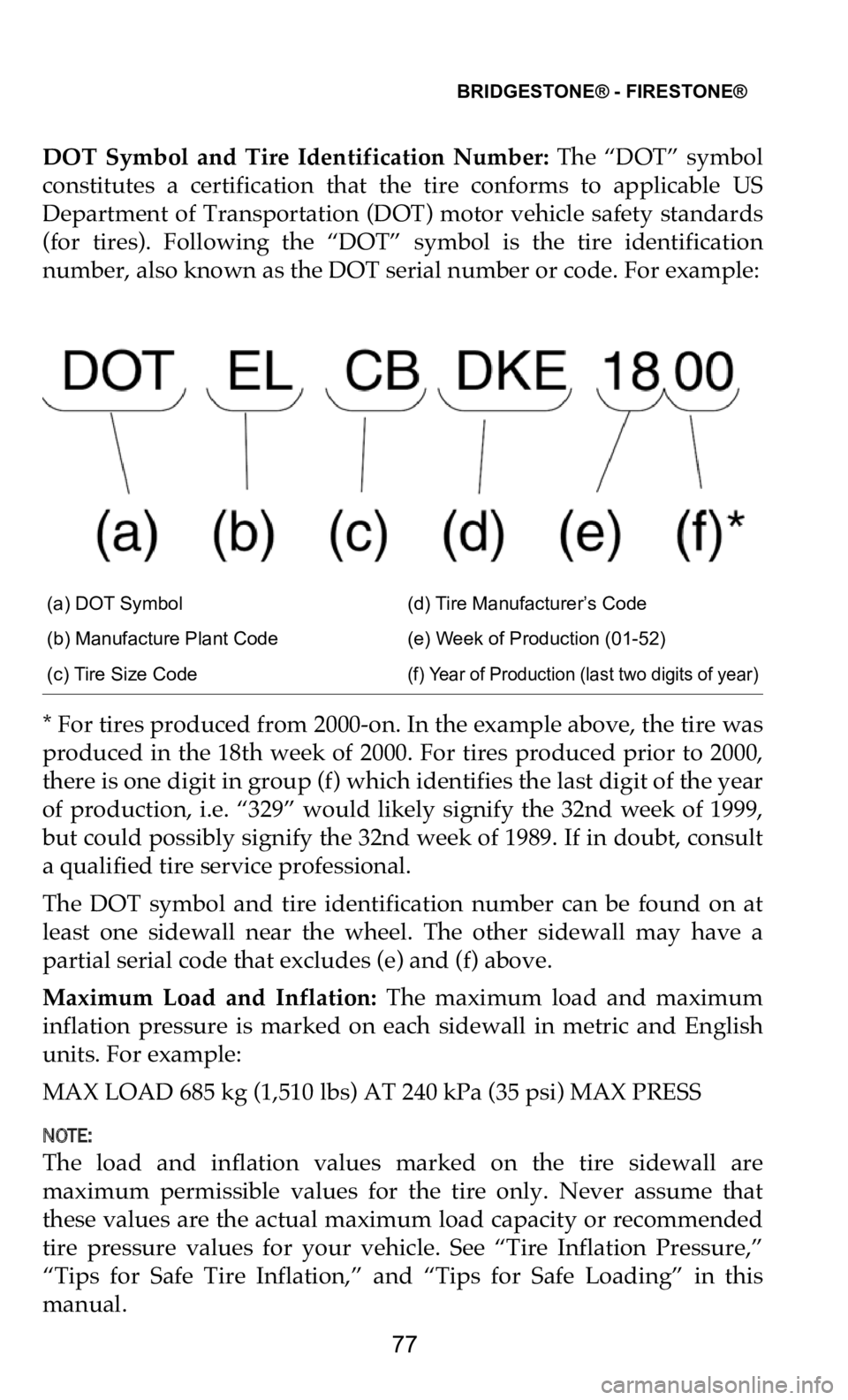load capacity DODGE DURANGO 2021 Vehicle Warranty
[x] Cancel search | Manufacturer: DODGE, Model Year: 2021, Model line: DURANGO, Model: DODGE DURANGO 2021Pages: 262, PDF Size: 10.42 MB
Page 6 of 262

TIRES
5
Tire Terminology And Definitions
Tire Loading And Tire Pressure
NOTE:
The proper cold tire inflation pressure is listed on the driver side
B-
pillar or the rear edge of the driver side door.
Term Definition
B-pillar The vehicle B-pillar is the structural member of the
bo
dy located behind the front door.
Cold Tire Inflation Pressure Cold tire inflation pressure is defined as the tire
pr
essure after the vehicle has not been driven for
at least three hours, or driven less than 1 mile
(1
.6 km) after sitting for a minimum of three hours.
In
flation pressure is measured in units of PSI
(pounds per square inch) or kPa (kilopascals).
Maximum Inflation Pressure The maximum inflation pressure is the maximum
pe
rmissible cold tire inflation pressure for this tire.
The maximum inflation pressure is molded into the
sidewall.
Recommended Cold Tire In
flation Pressure Vehicle manufacturer's recommended cold tire
in flation pressure as shown on the tire placard.
Tire Placard A label permanently attached to the vehicle
de
scribing the vehicle’s loading capacity, the
original equipment tire sizes and the
recommended cold tire inflation pressures.
Page 8 of 262

TIRES
7
Tire And Loading Information Placard
Tire And Loading Information Placard
This placard tells you important information about the:
• Number of people that can be carried in the vehicle.
•
Total weight your vehicle can carry.
•
Tire size designed for your vehicle.
•
Cold tire inflation pressures for the front, rear, and spare tires.
L
oading
The vehicle maximum load on the tire must not exceed the load
ca
rrying capacity of the tire on your vehicle. You will not exceed the
tire's load carrying capacity if you adhere to the loading conditions,
tire size, and cold tire inflation pressures specified on the Tire and
Loading Information placard in “Vehicle Loading” in the “Starting
And Operating” section of your Owner’s Manual.
NOTE:
Under a maximum loaded vehicle condition, Gross Axle Weight
Ra
tings (GAWRs) for the front and rear axles must not be exceeded.
For further information on GAWRs, vehicle loading, and trailer
to
wing, refer to “Vehicle Loading” in the “Starting And Operating”
section of your Owner’s Manual.
To determine the maximum loading conditions of your vehicle, locate
th
e statement “The combined weight of occupants and cargo should
Page 9 of 262

TIRES
8
never exceed XXX kg or XXX lbs” on the Tire and Loading Information
placard. The combined weight of occupants, cargo/luggage and
trailer tongue weight (if applicable) should never exceed the weight
referenced here.
Steps For Determining Correct Load Limit:
(1) Locate the statement “The combined weight of occupants and
ca
rgo should never exceed XXX kg or XXX lbs.” on your vehicle's
placard.
(2) Determine the combined weight of the driver and passengers that
wi
ll be riding in your vehicle.
(3) Subtract the combined weight of the driver and passengers from
XX
X kg or XXX lbs.
(4) The resulting figure equals the available amount of cargo and luggage
lo
ad capacity. For example, if “XXX” amount equals 1,400 lbs. and there
will be five 150 lb passengers in your vehicle, the amount of available
cargo and luggage load capacity is 650 lbs. (1,400-750 (5x150) = 650 lbs.)
(5) Determine the combined weight of luggage and cargo being loaded
on
the vehicle. That weight may not safely exceed the available cargo
and luggage load capacity calculated in Step 4.
(6) If your vehicle will be towing a trailer, load from your trailer will be
tr
ansferred to your vehicle. Consult this manual to determine how this
reduces the available cargo and luggage load capacity of your vehicle.
Metric Example For Load Limit
For example, if “XXX” amount equals 635 kg and there will be five 68 kg
pa
ssengers in your vehicle, the amount of available cargo and luggage
load capacity is 295 kg (635-340 (5x68) = 295 kg) as shown in step 4.
NOTE:
• If your vehicle will be towing a trailer, load from your trailer will be
transferred to your vehicle. The following table shows examples on
how to calculate total load, cargo/luggage, and towing capacities of
your vehicle with varying seating configurations and number and
size of occupants. This table is for illustration purposes only and
may not be accurate for the seating and load carrying capacity of
your vehicle.
• For the following example, the combined weight of occupants and
c
argo should never exceed 865 lbs (392 kg).
Page 10 of 262

TIRES
9
WARNING!
Overloading of your tires is dangerous. Overloading can cause
ti
re failure, affect vehicle handling, and increase your stopping
distance. Use tires of the recommended load capacity for your
vehicle. Never overload them.
Page 13 of 262

TIRES
12
Example: If garage temperature = 68°F (20°C) and the outside
temperature = 32°F (0°C) then the cold tire inflation pressure should
be increased by 3 psi (21 kPa), which equals 1 psi (7 kPa) for every 12°F
(7°C) for this outside temperature condition.
Tire pressure may increase from 2 to 6 psi (13 to 40 kPa) during
op
eration. DO NOT reduce this normal pressure build up or your tire
pressure will be too low.
Tire Pressures For High Speed Operation
FCA US LLC advocates driving at safe speeds and within posted
sp
eed limits. Where speed limits or conditions are such that the
vehicle can be driven at high speeds, maintaining correct tire inflation
pressure is very important. Increased tire pressure and reduced
vehicle loading may be required for high-speed vehicle operation.
Refer to an authorized tire dealer or original equipment vehicle dealer
for recommended safe operating speeds, loading and cold tire
inflation pressures.
Radial Ply Tires
WARNING!
High speed driving with your vehicle under maximum load is
da
ngerous. The added strain on your tires could cause them to
fail. You could have a serious collision. Do not drive a vehicle
loaded to the maximum capacity at continuous speeds above
75 mph (120 km/h).
WARNING!
Combining radial ply tires with other types of tires on your
ve
hicle will cause your vehicle to handle poorly. The instability
could cause a collision. Always use radial ply tires in sets of four.
Never combine them with other types of tires.
Page 14 of 262

TIRES
13
Tire Repair
If your tire becomes damaged, it may be repaired if it meets the
fo
llowing criteria:
• The tire has not been driven on when flat.
•
The damage is only on the tread section of your tire (sidewall
d
amage is not repairable).
• The puncture is no greater than a ¼ of an inch (6
mm).
Consult an authorized tire dealer for tire repairs and additional
in
formation.
Damaged Run Flat tires, or Run Flat tires that have experienced a loss
of
pressure should be replaced immediately with another Run Flat tire
of identical size and service description (Load Index and Speed
Symbol).
Run Flat Tires — If Equipped
Run Flat tires allow you the capability to drive 50 miles (80 km) at
50
mph (80 km/h) after a rapid loss of inflation pressure. This rapid
lo
ss of inflation is referred to as the Run Flat mode. A Run Flat mode
occurs when the tire inflation pressure is of/or below 14 psi (96 kPa).
Once a Run Flat tire reaches the run flat mode it has limited driving
capabilities and needs to be replaced immediately. A Run Flat tire is
not repairable.
It is not recommended to drive a vehicle loaded at full capacity or to
to
w a trailer while a tire is in the Run Flat mode.
See the Tire Pressure Monitoring System section for more information.
Tire Spinning
When stuck in mud, sand, snow, or ice conditions, do not spin your
ve
hicle's wheels above 30 mph (48 km/h) or for longer than 30 seconds
co
ntinuously without stopping.
Refer to “Freeing A Stuck Vehicle” in “In Case Of Emergency” in your
Ow
ner’s Manual for further information.
Page 17 of 262

TIRES
16
It is recommended to replace the two front tires or two rear tires as a
pair. Replacing just one tire can seriously affect your vehicle’s
handling. If you ever replace a wheel, make sure that the wheel’s
specifications match those of the original wheels.
It is recommended you contact an authorized tire dealer or original
eq
uipment dealer with any questions you may have on tire
specifications or capability. Failure to use equivalent replacement tires
may adversely affect the safety, handling, and ride of your vehicle.
WARNING!
• Do not use a tire, wheel size, load rating, or speed rating other
t
han that specified for your vehicle. Some combinations of unap -
proved tires and wheels may change suspension dimensions and
pe
rformance characteristics, resulting in changes to steering,
handling, and braking of your vehicle. This can cause unpredict -
able handling and stress to steering and suspension compo -
nents. You could lose control and have a collision resulting in
se
rious injury or death. Use only the tire and wheel sizes with
load ratings approved for your vehicle.
• Never use a tire with a smaller load index or capacity, other than
w
hat was originally equipped on your vehicle. Using a tire with
a smaller load index could result in tire overloading and failure.
You could lose control and have a collision.
• Failure to equip your vehicle with tires having adequate speed
c
apability can result in sudden tire failure and loss of vehicle
control.
CAUTION!
Replacing original tires with tires of a different size may result in
fa
lse speedometer and odometer readings.
Page 33 of 262

BFGOODRICH® TIRES
32
SPEED RATINGS
Speed Symbols are shown on the sidewall of some BFGoodrich® tires.
Th
e following table shows the maximum speed corresponding to the
symbol.
*Some V (or VR) rated tires may have a speed capacity greater than
14
9 mph (240 km/h). Consult your participating BFGoodrich® tire
re
tailer for maximum speed rating if your vehicle capability exceeds
this speed.
**Z (or ZR) rated tires are designed to use on cars with maximum
sp
eed capabilities in excess of 149 mph (240 km/h).
W and Y speed ratings are sub-categories of Z.
Consult your BFGoodrich® tire retailer for maximum speed
ca
pabilities.
Although a tire may be speed-rated, we do not endorse the operation
of
any vehicle in an unsafe or unlawful manner. Speed ratings are
based on laboratory tests which relate to performance on the road, but
are not applicable if tires are underinflated, overloaded, worn out,
damaged, altered, improperly repaired, or retreaded. Furthermore, a
tire’s speed rating does not imply that vehicles can be safely driven at
the maximum speed for which the tire is rated, particularly under
adverse road and weather conditions or if the vehicle has unusual
characteristics.
BFGoodrich® highway passenger tires that do not have a speed
s y
mbol on the sidewall have a maximum speed rating of 105 mph
(1
70 km/h). Light truck highway tires that do not have a speed
sy
mbol on the sidewall of the tire have a maximum speed rating of
87 mph (140 km/h).
The speed and other ratings of retreaded tires are assigned by the
re
treader and replace the original manufacturer’s ratings.
NOTE:
In order to maintain the speed capability of the vehicle, replacement
ti
res must have speed ratings equal to or higher than those fitted as
original equipment as indicated on the vehicle tire placard or Owner’s
Manual. If tires with lower speed ratings are fitted, the vehicle’s
handling may be affected and the speed capability of the vehicle will
be lowered to the maximum speed capability of the replacement tires
as indicated in the following table.
Page 75 of 262

BRIDGESTONE® - FIRESTONE®
74
SPECIAL SERVICE AND REPAIR ISSUES
Run-Flat Certified Retailers
Because of the advanced technology and design of Run-Flat tires and
th
e required Tire Pressure Monitoring Systems (TPMS), Bridgestone®
Firestone® Run-Flat Certified Retailers are specially trained to sell and
service RFT tires.
Run-Flat Certified Retailers have the necessary equipment and are
sp
ecially trained to properly mount and demount RFT tires and to
handle TPMS devices. Conventional mounting equipment may
irreparably damage RFT tires and an improper repair is unsafe and
will void the Limited Warranty. Accordingly, it is important to go to
a Bridgestone® Firestone® Run-Flat Certified Retailer for tire
maintenance and replacement.
Call toll-free 1-877-BFS-4RFT or, 87
7-237-4738 or visit
www.bridgestonetire.com
to locate the nearest Bridgestone®
Firestone® Run-Flat Certified Retailer.
Inspection after Run-Flat or Low Pressure Operation
Following run-flat or low tire pressure operation, or in the event of
an
y other tire damage or unusual condition, it is very important to
obtain a proper and complete tire evaluation as soon as possible.
Rotation
Follow the vehicle manufacturer’s recommendations, or rotate every
5,
000 miles per the recommendations in this manual (see “Radial Tire
Ro
tation”). In some cases, TPMS devices require reprogramming with
each tire rotation.
RFT Tire Replacement
Do not replace or mix RFT tires with conventional tires, unless on an
em
ergency/temporary basis. Conventional tires do not have run-flat
capability and the handling characteristics of the vehicle with these
tires may be different. If a conventional tire is used on an emergency/
temporary basis, verify that its size, load capacity, inflation pressure,
and speed rating specifications meet the requirements of the vehicle.
Replace any conventional tire with the proper RFT tire as soon as
possible.
Page 78 of 262

BRIDGESTONE® - FIRESTONE®
77
DOT Symbol and Tire Identification Number: The “DOT” symbol
constitutes a certification that the tire conforms to applicable US
Department of Transportation (DOT) motor vehicle safety standards
(for tires). Following the “DOT” symbol is the tire identification
number, also known as the DOT serial number or code. For example:
* For tires produced from 2000-on. In the example above, the tire was
p r
oduced in the 18th week of 2000. For tires produced prior to 2000,
there is one digit in group (f) which identifies the last digit of the year
of production, i.e. “329” would likely signify the 32nd week of 1999,
but could possibly signify the 32nd week of 1989. If in doubt, consult
a qualified tire service professional.
The DOT symbol and tire identification number can be found on at
le
ast one sidewall near the wheel. The other sidewall may have a
partial serial code that excludes (e) and (f) above.
Maximum Load and Inflation: T
he maximum load and maximum
inflation pressure is marked on each sidewall in metric and English
units. For example:
MAX LOAD 685 kg (1,510 lbs) AT 240 kPa (35 psi) MAX PRESS
NOTE:
The load and inflation values marked on the tire sidewall are
ma
ximum permissible values for the tire only. Never assume that
these values are the actual maximum load capacity or recommended
tire pressure values for your vehicle. See “Tire Inflation Pressure,”
“Tips for Safe Tire Inflation,” and “Tips for Safe Loading” in this
manual.
(a) DOT Symbol (d) Tire Manufacturer’s Code
(b) Manufacture Plant Code (e) Week of Production (01-52)
(c) Tire Size Code
(f) Year of Production (last two digits of year)